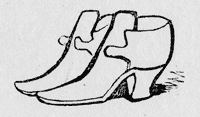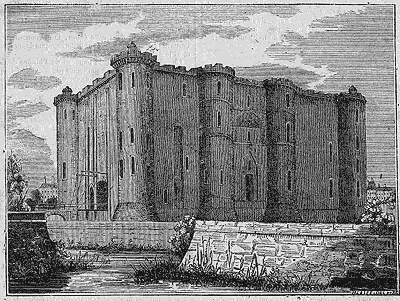|

NOTES ON ISSUE 2: GLOSSARY
PART 3 OF 3
…a white-haired man sat on a low
bench, stooping forward and very busy, making shoes.
Commentators identify various sources for Dickens’ representation of
the effects of Doctor Manette’s long imprisonment, and for his
occupation of making shoes. Perhaps the most significant are Dickens’
own observations – recorded in
American Notes – of prisoners in Philadelphia. His account,
which seems to have contributed to the fictional character and
occupation of Doctor Manette, runs as follows:
The system here, is rigid, strict,
and hopeless solitary confinement. I believe it, in its effects, to be
cruel and wrong…. I hold this slow and daily tampering with the
mysteries of the brain, to be immeasurably worse than any torture of
the body: and because its ghastly signs and tokens are not so palpable
to the eye and sense of touch as scars upon the flesh; because its
wounds are not upon the surface, and it extorts few cries that human
ears can hear; therefore I the more denounce it, as a secret punishment
which slumbering humanity is not roused up to stay…. Standing at the
central point, and looking down these dreary passages, the full repose
and quiet that prevails, is awful. Occasionally, there is a drowsy
sound from some lone weaver’s shuttle, or shoemaker’s last, but it is
stifled by the thick walls and heavy dungeon door, and only serves to
make the general stillness more profound. Over the head and face of
every prisoner who comes into this melancholy house, a black hood is
drawn; and in this dark shroud, an emblem of the curtain dropped
between him and the living world, he is led to the cell from which he
never again comes forth, until his whole term of imprisonment has
expired. He never hears of wife or children; home or friends; the life
or death of any single creature. He sees the prison officers, but with
that exception he never looks upon a human countenance, or hears a
human voice. He is a man buried alive; to be dug out in the slow round
of years; and in the meantime dead to everything but torturing
anxieties and horrible despair…. (qtd. in Sanders 50-1)
Doctor Manette, being “recalled to life”
– disinterred, as Dickens imagines the American prisoners
to be after years of solitary confinement – resembles
the inmates of the Philadelphia Penitentiary in experience,
demeanor, and occupation (the making of shoes).
There may also be additional reasons
for Manette’s shoemaking. Sanders notes that the Dickens family had
been acquainted with a shoemaker in the French town of Boulogne-sur-Mer
when they stayed there in 1854 (a few years prior to the composition of
A Tale of Two Cities)
and had adopted the shoemaker’s dog (whom they renamed “Cobbler”) when
the man was unable to pay the tax on the animal (48). Maxwell, on the
other hand, includes material in his edition of the novel suggesting a
connection between shoemaking and revolutionaries: “[A] popular
newspaper of Revolutionary France, Révolutions
de Paris, invented as its quintessential figure of the people ‘Jacques Cordonnier’ (James
Shoemaker), a salt-of-the-earth artisan who frequently offered up his
own opinions on matters of the day” (429). In addition, Maxwell
proposes a relationship between the figure of a violent revolutionary
(and shoemaker) called Simon in Alexandre Dumas’ 1845 Le Chevalier de la Maison-Rouge and
Doctor Manette, suggesting that Doctor Manette’s occupation may
represent “not just the obsessive hobby of a man who has temporarily
lost his mind,” but also “a masked but powerfully cumulative expression
of anger” (430). In this view, shoemaking is symbolic of revolutionary
feeling, and represents Doctor Manette’s repressed rage against the
injustices of the ancien
régime.
“It is a lady’s shoe. It is a young lady’s walking-shoe.
It is in the present mode. I never saw the mode. I have had a pattern
in my hand.”
Though it seems unlikely that the shoe constructed by the Doctor
is still in the “present mode” (since – as
we subsequently discover – he has been imprisoned for
nearly twenty years), we know that the “young lady’s
walking-shoe” that he makes is fashioned – since
he is recovered by his daughter in 1775 – after a pattern
stylish sometime between the late 1750s and 1775. Women’s
shoes in the mid-18th century tended to have high heels and
pointed toes. Fairholt’s Costume in England, A History of Dress (1860)
reproduces a young lady’s walking shoe which may serve
as a fair illustration of the kind of shoe the Doctor is making.

This figure illustrates a typical
walking shoe of the early- to mid-18th century, “in the first fashion,
with high tops and formidable heels, made to walk, but not to run in”
(394). Though the Doctor would be making a shoe in the mode of a
somewhat later date (the above figure is copied from an engraving by
Hogarth of 1732), it would probably differ mainly in ornamentation; the
high heels and pointed toes remained popular until the end of the
century (Fairholt 394-5). Also, though Fairholt’s engraving shows
English shoes, French ladies’ walking shoes would be of very similar
construction. The English tended to follow French fashions in the 18th
century, even to the extent of adopting styles that came into vogue as
a result of the French Revolution (Fairholt 312-28).
“One Hundred and Five, North Tower.”
The fact that Doctor Manette gives “One Hundred and Five, North Tower”
as his name demonstrates the extent to which he has identified himself
with his imprisonment, and helps explain the persistence of his belief
that he is still in the Bastille. The Bastille had eight towers, two of
which were on the north side – the Tour du Puits and the Tour du Coin.
Editors of A Tale of Two Cities
generally identify “One Hundred and Five, North Tower” as a somewhat
inaccurate and wholly invented representation of part of the Bastille
(Sanders 51), yet this invention – especially the fact that Dickens did
not distinguish between the two northern towers – seems partly
authorized by the fact that the Bastille had not existed since 1789.
Carlyle himself – Dickens’ chief historical source – declares that
To describe [the] Siege of the
Bastille (thought to be one of the most important in History) perhaps
transcends the talent of mortals. Could one but, after infinite
reading, get to understand so much as the plan of the building! But
there is open Esplanade, at the end of the Rue Saint-Antoine; there are
such Forecourts, Cour Avancé, Cour de l’Orme, arched Gateway …;
then new drawbridges, dormant-bridges, rampart-bastions, and the grim
Eight Towers: a labyrinthic Mass, high-frowning there, of all ages from
twenty years to four hundred and twenty…. (161-2)
Built in the 14th century by Charles V
and VI of France, the Bastille originally had four towers, and four
more were added by 1553; the whole period of its construction was thus
roughly 1370-1553. Originally, the Bastille stood on the eastern
outskirts of Paris, and was used as a fortress. In 1670, when the walls
of the city were leveled, the Bastille remained standing (Handbook to Paris 128-9); and the
castle was used, from the reign of Louis XI onward, not as a fortress,
but as a jail for state prisoners (Dickens’s
Dictionary of Paris 20) – “chiefly for the confinement of
persons of rank who had fallen victims to the intrigues of the court or
the caprice of the government” (Baedeker 68). Accounts of the
construction of the Bastille vary – the walls are sometimes said to
have been six feet thick (Dickens’s
Dictionary of Paris 20), sometimes nine (Carlyle 161), sometimes
ten (Baedeker 68-9); but most agree that the building was oblong,
surrounded by a mote, with towers in the corners. One
early-20th-century guidebook describes it as “a rectangle with a tower
at each corner and two in each of the long sides, and very much
resembling a billiard table with eight pockets” (Handbook 128-9), and a model of it
can still be seen at the Musée Carnavalet in Paris. Today, the
Place de la Bastille still marks the site of the fallen fortress, but
nothing of the building itself remains. However, the Pont de la
Concorde, which crosses the Seine from the present Place de la Concorde
(which was called the “Place de Louis XV” in 1775, and the “Place de la
Révolution” during the Revolution), was under construction from
1787-1790, and was partly built with stones from the fallen Bastille.
One of its first names, for this reason, was “Pont de la
Révolution” (Dickens’s
Dictionary of Paris 41).
This illustration of the Bastille, as it appeared before 1789 – with
eight towers, mote, drawbridge, etc. – is taken from the Histoire de Paris (1869).

La Bastille
In its present condition, the Place de
la Bastille features a column – the Colonne de Juillet – erected in
commemoration of the July Revolution of 1830. Since 1989 it has been
the location of the Opera de la Bastille, which was opened on the
bicentennial of the French Revolution (Baillie and Salmon 129).
They heard him mutter, “One hundred and Five, North
Tower”; and when he looked about him, it evidently was for the strong
fortress-walls which had long encompassed him. On their reaching the
court-yard, he instinctively altered his tread, as being in expectation
of a drawbridge….
The Bastille was protected by a mote, and was entered by means of a
drawbridge. In fact, from accounts of the fall of the Bastille
(Baedeker 68-9, Carlyle 161), it seems that not only the first interior
court of the Bastille was protected by a drawbridge, but that the
second was likewise. Doctor Manette, still believing himself to be
incarcerated in the Bastille, would alter his steps in anticipation of
crossing at least one drawbridge.
Defarge got upon the box, and gave the word “To the
Barrier!”
The Barriers of Paris, at which taxes were collected on goods passing
into the city, were erected under Louis XVI’s Controller-General of
Finance, M. de Calonne. However, the wall in which the Barriers were
set was not completed until 1786, and would still have been under
construction at the historical moment represented in this part of the
novel (1775). The tax-wall Barriers were besieged in 1789, and their
customs-duties abolished in 1791; most of the actual gates survived
into the period in which Dickens was composing the novel, but today,
only the Barrières d’Enfer, de Vincennes, de la Villette and de
Monceau are still extant (Sanders 108). Sanders identifies the Barrier
to which Defarge demands they proceed as either the Barrière
St.-Denis or the Barrière de la Villette, as these northern
gates “commanded the roads to the northern coastal ports” (52) where
the Manettes and Mr. Lorry could take passage for England.
Beneath that arch of
unmoved and eternal lights: some, so remote from this little earth that
the learned tell us it is doubtful whether their rays have ever yet
discovered it, as a point in space where anything is suffered or done…
This – “what the learned tell us” about the “unmoved and eternal
lights” (the stars) – was a commonplace of 19th-century astronomy. The Young Ladies’ Astronomy, for
instance – which is a general account of astronomy for the instruction
of girls published in 1825 – makes the following remarks upon the
distance of the stars: “Some stars are supposed to be so remote, that
their first ray of light, shot forth at the moment of creation, and
moving at the astonishing rate of about 200,000 miles a second, has not
yet reached our globe” (80). Light, according to modern calculations,
moves at 299,792,458 meters per second – a little over 186,000 miles
per second – in a vacuum.
Bibliographical information
|

